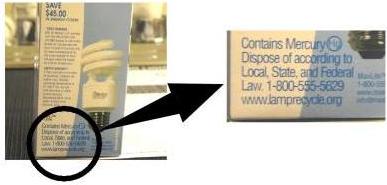Compact Fluorescent Lamps
While compact fluorescent bulbs (CFL) are much more efficient than the previous generation of incandescent lamps, they do contain a small amount of mercury (about 5 mgs). LED lamps are even more efficient and do not contain mercury, so they are a better choice. Linear tubes are also widely available in LED technology.
The mercury in a CFL is necessary for the lamp to work. An intact bulb does not pose a human health threat. They should be handled carefully to avoid breakage and disposed of through the properly, as described below.
Labeling

Connecticut law requires that products containing mercury be labeled. The purpose of the label is to inform the consumer that the product contains mercury and advise them to dispose of the lamp properly. Typical labeling on packaging of CFLs reads: "Contains Mercury. Dispose of according to Local, State and Federal Law".
In addition, you may find the symbol  on linear four-foot fluorescent lights.
on linear four-foot fluorescent lights.
Hg is the periodic symbol of the element mercury.
What To Do When A CFL Breaks
Proper use and handling of CFLs in the home should not result in any exposure to mercury. Handle the lamp carefully, installing and removing by the base, never the glass. However, should a CFL break, refer to the Connecticut Department of Public Health's Fact Sheet, Compact Fluorescent Light Bulbs: What To Do If A Bulb Breaks, for detailed clean-up instructions.
Proper Disposal - What It Means And Where To Take CFLs When They Burn Out
Business and other non-residential generated mercury lights are subject to state hazardous waste laws and regulations that prohibit their disposal in the solid waste stream. CFLs and other fluorescent lighting generated by residents are exempt from these disposal restrictions. However, the Department strongly encourages residents to recycle their lamps through town drop offs and household hazardous waste collections. By recycling your burned out CFLs, you help keep mercury out of our environment.
CFLs are accepted at household hazardous waste collections. Refer to the schedule of household hazardous waste collections for a location near you. Some municipalities offer recycling of CFLs and other fluorescent lamps at their transfer stations or other drop sites. Check with your local recycling coordinator or Department of Public Works for more information.
In 2008, The Home Depot began a collection program for CFLs. Residents can bring any brand of compact fluorescent lamp, regardless of where it was purchased, to any Connecticut Home Depot. IKEA stores also accept CFLs for recycling. Some municipalities will accept CFLs and linear fluorescent lamps at their transfer station. Check your towns website for more information.
View more information on CFLs and on other home products which use less energy, save money and help to protect our environment.
For further information please contact the Bureau of Materials Management and Compliance Assurance at 860-424-3242 or e-mail Tom Metzner.
Related Links
Content Last Updated October 2019

